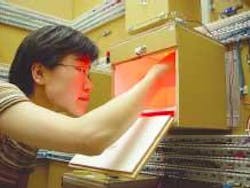Junction temperature becomes easy to measure
With their long life, ruggedness, and steadily improving brightness and efficiency, light-emitting diodes (LEDs) will inevitably become a major player in the general lighting market. The chief limiting factor on the widespread availability of LEDs for lighting is high cost, with LED efficiency (currently greater than that of incandescent lamps, but less than that of compact fluorescents) also a major factor. Lowering costs will come in part by removing hurdles to proper design of LED lighting systems.
An improperly designed LED lighting system may not last long—a result of nonideal LED operating conditions. Determining the lifetime of an LED system consists of running it until its light output falls below a predetermined fraction of its original output. This approach consumes too much time; with LED technologies rapidly advancing, such life data could become obsolete before long. Life information can be gathered more quickly by a test that predicts lifetime based on the operating temperature of the LED's junction. Even this test, however, is not viable because typically the LED system must be partially disassembled to expose the LED lead wires for measurement. Doing so may negatively affect the system's performance and result in inaccurate data.
To overcome these obstacles, a group led by Nadarajah Narendran, director of research at Rensselaer Polytechnic Institute's Lighting Research Center (LRC; Troy, NY), is developing methods to rapidly predict LED system life by measuring LED junction temperatures noninvasively.1, 2 Based on spectral measurements, the researchers' technique depends on the type of LED being characterized.
For red-emitting aluminum gallium indium phosphide (AlGaInP) LEDs, the researchers realized that, because peak wavelength is a function of junction temperature for any particular formulation of AlGaInP LED, a measurement of peak wavelength shift gives a temperature change that, when added to the temperature of the surroundings, gives the junction temperature. As it runs hotter, an AlGaInP LED spectrum shifts to longer wavelengths, says Narendran. "The relationship between peak wavelength and junction temperature is linear and very predictable," he notes. "However, knowing junction temperature alone is not sufficient. The degradation rate as a function of temperature is also needed in order to predict lifetime."
White-light LEDs, which are based on gallium nitride combined with a cerium-containing phosphor, have a smaller temperature-dependent spectral shift. "Gallium nitride is a whole different story," says Narendran. "An increase in current shifts the wavelength in one direction, while an increase in temperature shifts the wavelength in the other; the two effects tend to cancel out in real devices." In this case, the LRC researchers take advantage of the fact that the ratio of radiant energy within the blue-emission peak to the total (LED and phosphor) radiant energy changes with junction temperature. For blue- and green-emitting GaN-based LEDs with no phosphors, Narendran and his colleagues are working on alternative spectrum-based degradation-measurement techniques.
White-light-LED variants under development around the world include ultraviolet emitters combined with white-light phosphors. For these devices, another form of characterization may be needed. One possibility is the spectrum-based technique Narendran is pursuing for blue- and green-emitting LEDs.
Manufacturers' data needed
To buttress their data, the RPI group is doing standard life tests on LEDs. Narendran notes that LED manufacturers could do a service to the industry by providing data on degradation rate vs. junction temperature for their devices. Such information would help lighting-system manufacturers to best integrate the LEDs into fixtures for long life.
The RPI researchers are devoting attention to the newer high-flux LEDs, which are often constructed as single large chips or multiple chips mounted directly to a metal substrate. "The [conventional] 5-mm LEDs have been easy to test, as they are cheap and fail relatively quickly," says Narendran. "But the higher-flux devices are more interesting."
Through funding from the U.S. Department of Energy and in cooperation with the University of California at Santa Barbara, the LRC is currently characterizing the performance of high-flux LEDs. "An interesting switch has occurred," says Narendran. "While the earlier 5-mm white LEDs failed more quickly than red LEDs, now the higher-flux white LEDs are lasting longer than the red."
REFERENCES
- E. Hong and N. Narendran, Proc. SPIE 5187 (2003).
- Y. Gu and N. Narendran, Proc. SPIE 5187 (2003).

